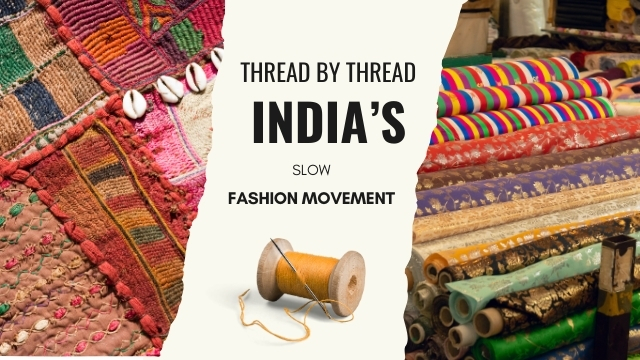As climate conversations get louder and the fast fashion industry faces growing scrutiny, a quiet but powerful fashion revolution is unfolding across India. Unlike fleeting trends that thrive on mass production and markdowns, this one is built on slowness, soul, and sustainability. Welcome to the world of slow fashion—where craft meets conscience, and every garment tells a story.
What began as a counter-response to fast fashion’s environmental and ethical fallout has evolved into a nationwide lifestyle shift. Designers, weavers, artisans, and consumers are reconnecting with India’s textile heritage, choosing clothing that honours tradition, empowers communities, and nurtures the planet.
The Slow Fashion Shift: From Fast to Thoughtful
In essence, slow fashion is the antithesis of fast fashion. It prioritizes mindful production, ethical sourcing, local artistry, and long-lasting design over seasonal turnover and synthetic fabrics. In India, where textile craftsmanship is deeply woven into the cultural fabric, this movement has found a natural home.
From handloom saris in Bengal to Ajrakh block prints in Gujarat and Chikankari embroidery in Lucknow, slow fashion in India is more than aesthetic—it’s a celebration of legacy. What’s changing now is the mindset: consumers and creators alike are beginning to value provenance over price, purpose over perfection.
Many independent labels are shifting to small-batch production, natural fibres, and biodegradable dyes, not as a marketing ploy, but as a commitment to environmental responsibility and human dignity.
Reviving Craft, Restoring Dignity
India’s artisans have long been the invisible backbone of the global fashion supply chain. Yet for decades, traditional crafts were undervalued, underpaid, and often appropriated by commercial brands. The slow fashion movement is reversing that imbalance.
Emerging labels such as Okhai, Khara Kapas, Runaway Bicycle, The Summer House, Three Clothing, and Péro are not just collaborating with artisans—they’re building equitable business models. Fair wages, safe working conditions, skill development, and transparency are now part of the brand DNA.
At the same time, the design language is evolving. Slow fashion in India is not locked in nostalgia; it’s contemporary, wearable, and globally relevant. The blend of age-old techniques with modern silhouettes is attracting younger consumers who want meaningful minimalism—fashion with a deeper footprint and a lighter impact.
The Conscious Consumer Takes the Lead
Urban millennials and Gen Z are leading the shift toward sustainable fashion in India. Informed, vocal, and value-driven, they are questioning where their clothes come from and who made them. Their Instagram feeds are filled with capsule wardrobes, thrift finds, and handmade clothing—not just for aesthetic reasons, but for ethical ones.
They’re rejecting the idea of clothes as disposable. Instead, they’re embracing fewer, better pieces. They’re learning to care for garments, repurpose old clothing, and support homegrown labels over mass-market imports.
Social media has given ethical fashion a major boost. Platforms like Instagram and Pinterest have become digital runways for slow fashion, enabling smaller brands to tell their stories and reach audiences directly—without retail middlemen or expensive ad campaigns. Sustainability influencers, once a niche group, are now shaping mainstream tastes and trends.
Challenges on the Path to Mainstream
Despite its rising visibility, slow fashion still faces real hurdles in India. Higher price points remain a barrier for many consumers. Handmade, ethically produced clothing costs more to create, and often isn’t scalable in the same way as factory-made garments.
There’s also the challenge of educating the wider market—especially beyond urban metros. Many still view sustainable fashion as elite, impractical, or niche. Changing this perception will require consistent storytelling, accessible pricing, and greater investment in consumer awareness.
Logistics, availability, and production timelines can also be limiting for small ethical brands. With lower inventory and higher reliance on artisanal processes, slow fashion brands must work hard to balance ethics with efficiency.
Not Just Clothes, But Culture
What sets India’s slow fashion movement apart is its deep cultural resonance. It’s not just about saving the planet—it’s about reviving heritage, sustaining livelihoods, and reclaiming identity. Every handwoven textile, every naturally dyed kurta, and every handcrafted accessory is part of a larger narrative: one that values meaning over mass.
This is fashion that invites pause. That encourages connection. That doesn’t chase trends but builds trust—between maker, wearer, and the land.
As climate anxiety rises and fashion’s environmental toll becomes harder to ignore, slow fashion offers something radically hopeful: the idea that what we wear can heal, not just harm.
The momentum behind slow fashion in India is undeniable. From boutique labels to artisan co-ops, from digital thrift stores to upcycling workshops, a new era of conscious style is emerging.
It’s not about rejecting fashion—it’s about redefining it. Making space for garments that endure, for craftsmanship that matters, and for stories that live on in stitches and seams.
In a world of fast clicks and faster trends, India’s slow fashion movement is offering something rare: a chance to wear values, not just clothes.





